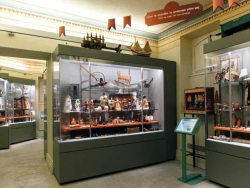Toy Museum of Athens

Toy Museum of Athens
A puppet created by theatrical set designer Dionysis Fotopoulos and a plank horse that Greece's iconic early-20th Century politician Eleftherios Venizelos gave to his grandson are just 2 of the pieces that welcome both children and adults at the entrance of the Museum of Toys on Poseidonos Avenue 14 & Tritonos Street 1, in Paleo Faliro.
The core collection of the museum was conceived around the pieces donated to Benaki by Athenian Maria Argyriadi - a School of Fine Arts graduate who has been accumulating and preserving toys and dolls since the 1970s. She is also a member of the United Federation of Doll Clubs, has authored 4 books, and has participated in many works for children's play. Her acquisitions now total over 20,000 pieces.
"I donated them to the Benaki Museum in 1991 when I realized that the final recipients must be the children", Ms. Argyriadi said. The permanent collections, that are among the most important in Europe, include toys, books & brochures, ephemera, clothing, and other items associated with childhood from Europe, Africa, Asia, the Americas, and the East as well.
Lastly, a specialist library open to all curious individuals holds more than 3,000 books and readings relating to children and toys, archival sources, photographs, information about Greek manufacturers, and works on children's literature and education, as well as general reference works.
The collection of children’s Toys and Games, as well as a precious archival stock, is housed in the Kouloura Building. The fairytale villa that houses the Toy Museum was built between 1897-1900 by Spyros Despozito, a mining entrepreneur who only lived there for 6 years. From 1906 to 1923, the home was rented by Dr. George Miliaresi, who used it as a spa and a private clinic for the members of the high bourgeois society of the time. After his death in 1911, it was purchased by a wealthy ship owner and benefactor, Athanasios Koulouras, in 1923, along with his sick wife Helen and Vera Kalogera, who was taking care of her. Helen died in 1929. A year later the shipowner married Vera Kouloura and she lived in the villa until her death in 1979. In 1976, following the desire of her late husband, she donated the building to the Benaki Museum in order to be transformed into a museum itself.
The architecture of the building consists of mainly Gothic elements with references to the European Middle Ages and Baroque. One can admire the Art Nouveau ceiling paintings and murals. The building was listed by the decision of the Ministry of Environment in 1997 and restoration procedures began in 2011 under the supervision of the Ministry of Culture.








